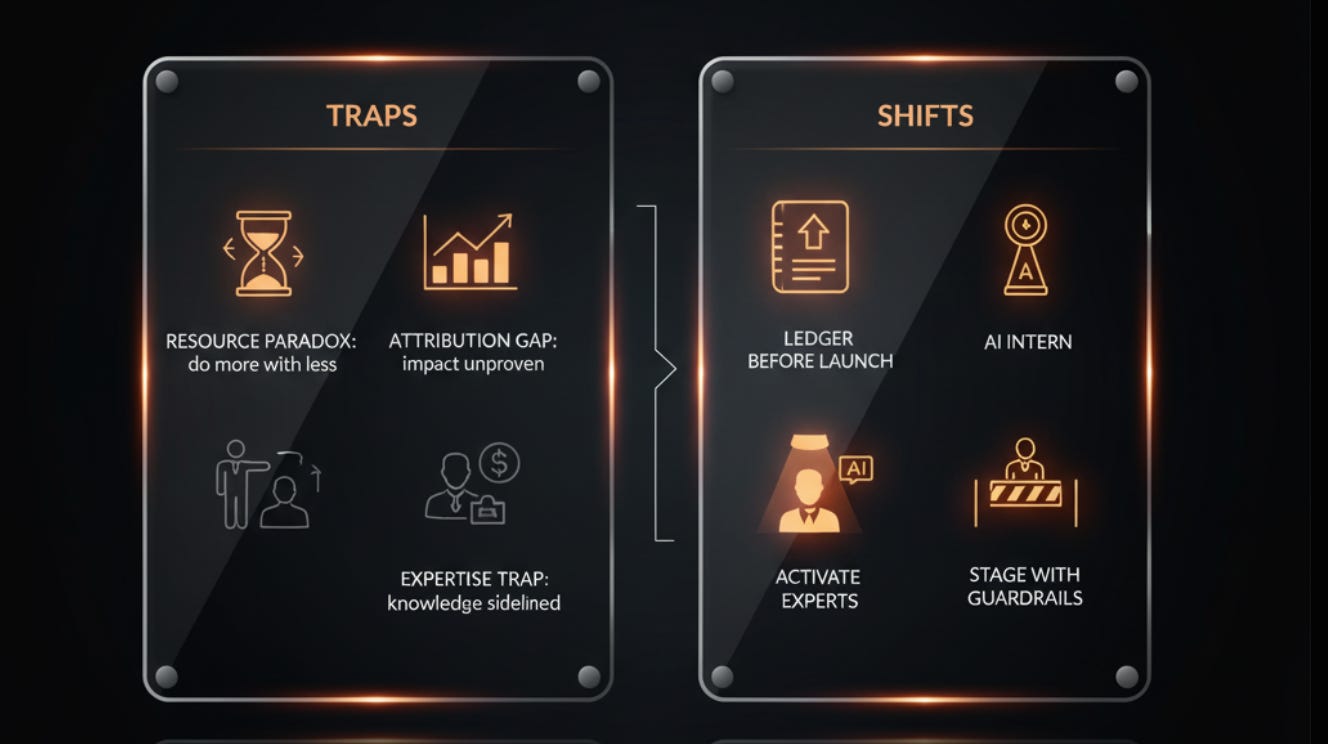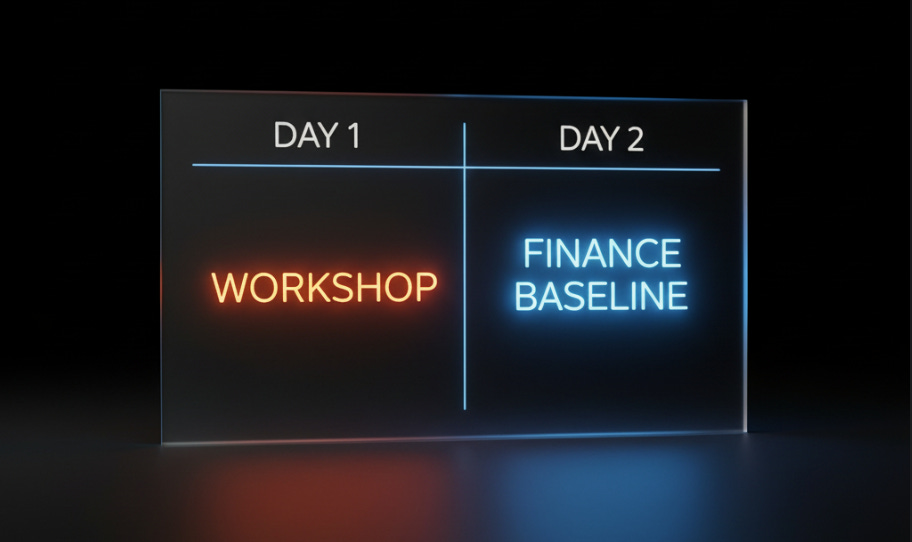How to Harness AI, Without Hiring an Army. Plus: Your Weekly AI News & Tools Digest
Most enterprise AI experiments fail, billions wasted, results missing. The outliers who win focus on execution discipline, not raw tech.
Most enterprise AI experiments fail, billions wasted, results missing. The outliers who win focus on execution discipline, not raw tech.
Recent research from MIT's initiative shows 75% of enterprise AI pilots never deliver measurable value. Only a small fraction make their way onto the P&L.
When AI is used well, the upside is sharp. Case studies from PwC point to returns of $4.50 for every $1 invested. In Australia, the AI economy is tipped to exceed $46 billion by 2030, led by healthcare, manufacturing, and agriculture. At the same time, AI capability has become the most in-demand skillset worldwide, with wage premiums at record highs.
The companies breaking through are the ones that tie AI directly to P&L outcomes, not tools or demos.
When you boil it down, three execution traps sink these projects before they start. But the 5% who succeed aren't using secret AI magic.......the real difference?
Execution discipline, not technical wizardry.
The Problem in Numbers
Three traps dominate failed AI programs:
Resource Paradox: Boards expect results with Tuesday’s budget and yesterday’s headcount. The "do more with less" mandate leads to fragmented, unsustainable rollouts.
Attribution Gap: Finance teams struggle to isolate AI-driven lifts from background business change. Without line of-sight to revenue or cost, claims of impact go unproven.
Expertise Trap: Business domain knowledge is sidelined in favour of newcomers and consultants, so major pain points go unsolved.
The Shift
What you need to focus on:
Ledger Before Launch: Tie every project to outcomes Finance can book. Start with "How will this move the needle in ways we can prove?"
Activate Your Experts: Use AI to accelerate domain work, not distract from it. The value comes from freeing up staff to do what only they can.
Stage with Guardrails: Treat each AI as an intern. Roll out by milestone, prove value and safety at each step before wider deployment.
This is a discipline and measurement game, not technical showmanship.
Business Impact
When executed with discipline, AI delivers measurable gains, no extra headcount, no runaway budgets, no major capital expenditure. Teams spend less time on grunt work and more time driving critical business outcomes.
The compound advantage goes beyond operations- it strengthens your strategic position. When economic pressures intensify, you’ll have operational flexibility your competitors lack, while they’re still burning cash on AI theatre.
Practical Action
Three steps separate you can execute in 48 hours:
Joint Workshop: Sales, operations, and finance score their biggest bottlenecks with criteria like business impact, AI-fit, data readiness, time-to-value, and stakeholder buy in. No slide decks, just scorecards. This isn't about consensus building or lengthy strategy sessions. It's pure CFO mathematics applied to operational constraints. Each bottleneck gets scored on a weighted scale where business impact carries the heaviest weighting. The output is a ranked list that Finance can defend to the board because the methodology follows the same rigour you'd apply to capital expenditure decisions.
Attribution Planning: Finance sets baselines and control measures before deployment. Measurement is designed in, not bolted on. This step requires establishing what economists call a "counterfactual" - what would have happened without AI intervention. You're essentially running a controlled experiment within your own operations. Most companies skip this step and later struggle to prove ROI because they can't separate AI improvements from natural business fluctuations, seasonal effects, or other operational changes happening simultaneously.
Stage Zero Deployment: AI tackles routine work under strict monitoring and human control. Think of this as the "training wheels" phase. The AI system handles the predictable, repetitive elements while humans maintain oversight and handle exceptions. This approach builds organisational confidence gradually while protecting against the verification tax problem where teams spend more time checking AI work than the AI saves. Success at this stage means the AI consistently handles routine tasks with error rates below your best human performers.
The pattern that emerges is clear: companies that succeed treat AI deployment like any other major operational initiative, with clear success metrics, defined accountability, and staged rollout protocols that allow for course correction without risking core business functions.
Closing
While most companies will keep burning cash on AI theatre, the winners apply execution rigour, financial logic, and governance vigilance, accelerating results without ballooning risk.
You can't control the speed of change, but you can control how fast your company adapts.
Executive Prompt of the Week
Strategic Blindspot Generator: Here's a quick exercise that often reveals assumptions you didn't know you were making. Drop this into ChatGPT:
"We are an executive team trying to increase business value without adding headcount. Our specific challenge is: [insert your issue here, e.g. 'reduce compliance costs' / 'de-risk AI vendor selection' / 'unlock margin in operations']. We've already considered the obvious options. Ask me tough, useful questions that expose blind spots, hidden risks, or overlooked opportunities. Don't give me answers — just the best questions."
The questions it surfaces can be more valuable than the answers.
Ignoring AI is the fastest way to fall behind. Subscribe for regular podcasts that cut through the noise and deliver outcomes leaders can use.
AI News & Tools Digest - All you need to know this week:
Top Story
Microsoft-OpenAI Partnership Restructures - OpenAI transitioned to Public Benefit Corporation status and secured a $300 billion Oracle infrastructure deal, while Microsoft integrated Anthropic's Claude into Office 365 applications. This signals the end of exclusive AI vendor partnerships across enterprise markets.
For Australian enterprises, this development reduces vendor lock-in risks and increases negotiating leverage. The multi-vendor approach is becoming standard practice. Review existing AI contracts and develop contingency strategies incorporating multiple providers (Azure, Oracle, Anthropic, OpenAI).
Tool of the Week
OpenAI's MCP Integration Creates Enterprise Opportunity and Risk - ChatGPT now connects directly to over 500 business applications through Model Context Protocol, enabling natural language queries across CRM systems, databases, and enterprise platforms.
Early Australian adopters report 40-60% time savings on routine reporting workflows. However, this access comes with governance risks that aren't widely understood yet. Data exfiltration through compromised MCP servers, accidental info leakage, and supply chain risks are all emerging concerns. Enterprise legal and security teams should be part of any MCP strategy from day one. Review connections, audit logs, and scope data access carefully before deployment.
Quick Roundup
Australia's AI Regulation Framework Advances - The government released draft guidelines for AI governance in critical infrastructure sectors. Key requirements include algorithmic auditing, human oversight protocols, and data sovereignty compliance. Implementation timeline: 12 months for financial services, 18 months for healthcare.
AI Copyright Costs Reach Billion Dollar Territory - Anthropic's landmark copyright settlement involving a $1.5 billion payout to authors for using pirated books, plus a confidential deal with The New York Times, marks the largest copyright settlement in U.S. history. Meanwhile, Penske Media (owner of Rolling Stone and Billboard) is suing Google for allegedly republishing articles in AI-generated search summaries, cutting into traffic and ad revenue. These cases establish precedents for Australian businesses: audit your AI training data now and determine whether to pursue protection or licensing strategies before legal costs spiral.
ChatGPT Enterprise Adoption Hits 1M+ Australian Businesses - OpenAI reports significant uptake across professional services, with 67% citing productivity improvements in document analysis and client communication workflows.
AI Spiritual Chatbots Hit 30M Downloads, Raise Ethics Questions - Apps like "Bible Chat" and websites offering users the ability to "chat with God" are gaining massive traction. While some religious leaders see potential for reaching new audiences, theologians warn that AI models "tell us what we want to hear" rather than providing challenging spiritual guidance. For Australian enterprises, this highlights how readily people trust AI advice across personal and professional domains. Consider transparency protocols if deploying AI for employee coaching or guidance—ensure staff understand they're interacting with algorithms, not human wisdom.
Australia's Ghost Shark Submarines Outpace U.S. Navy Timeline - The Australian Navy's A$1.7 billion deal with Anduril for AI-powered autonomous submarines demonstrates homegrown innovation at startup speed. Co-developed in just three years, these "Ghost Shark" drones will operate in Australian waters next year—faster deployment than U.S. counterparts. The success suggests Australian enterprises can leverage local AI talent and agile partnerships to outmaneuver slower global competitors in regulated industries.
Ads Coming to ChatGPT and Major Chatbots - Major AI platforms are preparing to introduce advertising, transforming chatbots into new marketing channels. For Australian businesses, this shift requires reassessing brand risks in chatbot deployments and considering how AI-generated responses might influence customer perceptions when mixed with sponsored content.
If this helped, forward it to one colleague who needs board-ready AI clarity.
Connect with me:
LinkedIn: HERE
Apple Podcasts: HERE
Spotify Podcast: HERE



